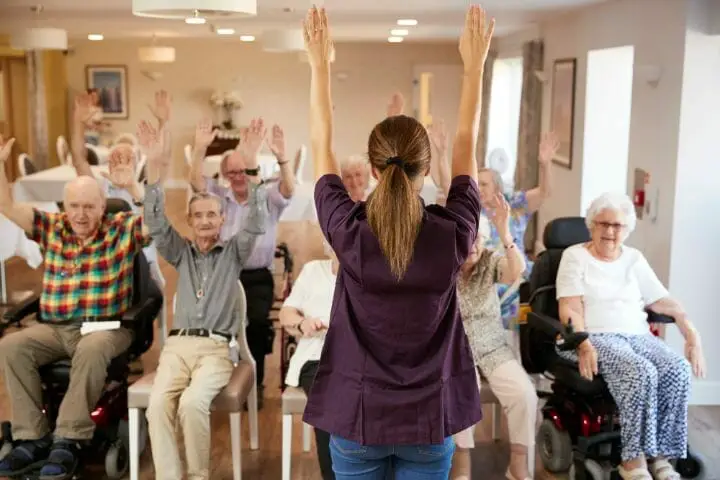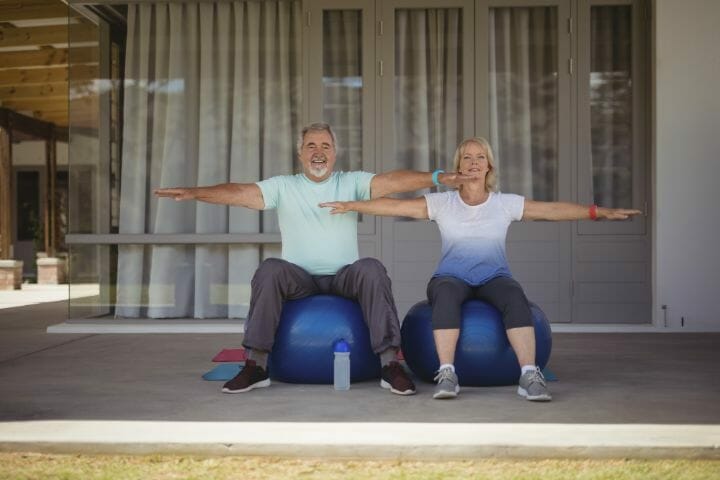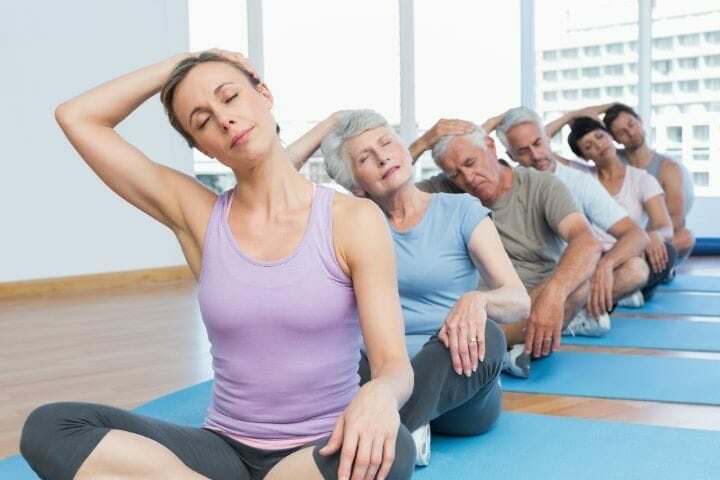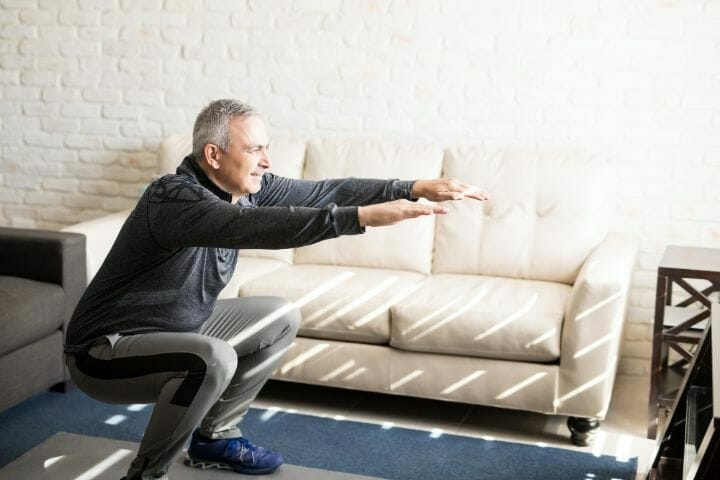My grandmother once said, “Humans should never sit still; we start to rust.” Those were wise words indeed but it would be even wiser to incorporate this in our daily lives. Physical activity & exercise benefits us for a healthier self.
No matter what your age is, engaging in some form of physical activity has shown to improve physical, mental, and emotional health. But as we age, physical inactivity has increased the risk of chronic disease, which leads to an increased mortality rate and permanent physical disabilities.
Among these are factors of high risk of falls. There is a direct link between a sedentary lifestyle and declining physical function.
Thus, sitting exercises are an alternative for older people who would like to remain active with limited mobility. Older folks also have problems particularly with standing activities and that doesn’t have to be the norm!
Contents
Benefits of Chair Exercises in Seniors
Improved Balance
One out of 5 fall-incidents causes serious injuries like fractures and concussions. There are fall-related admissions in the emergency room every 11 seconds. According to the National Council on Aging, every 19 minutes, an old person dies due to complications that arise from falls.
In order to strengthen the muscles required for stability such as your core and abdominal muscles, upper leg muscles, quads and hamstrings, light exercise should be included in one’s daily or weekly routine.
It’s not necessary to create an intense workout routine; performing the exercises below will greatly improve not only your health and quality of life, but also the way you feel about yourself. Improvement of strength can help prevent falls, and lessen the need for aid on activities.
Reduce Joint Stiffness
Joint pains may increase risk for falls based on research. With the increase in arthritis effects on joints, there can increase in the number of falls. Based on a study on Arthritis Research & Care in the year 2015, people with pain in one lower joint – their knee or hip – were 53 percent more likely to fall. Complaints of morning stiffness and pain are the primary symptoms of arthritis. This contributes to falling from the inability to walk, and stay in a standing position.
Mobility exercises are good for the bones and joints. It helps the flow of synovial fluid that acts like oil in an engine and allows your bones to move smoothly. By that, nutrients can flow and repair can happen to the affected joints.
Increase Mobility and Flexibility
Older adults who exercised 3-4 times per week saw an 18% improvement in mobility and an increase in their energy levels. This can help in walking easier and without complaints of pain.
By increasing the range of motion of your joints, going back to your daily routine will be possible. Elderly people will have assurance that they can do their usual activities without hesitation.
You may also like Ultimate Guide to Aging Well
Preparation and Equipment
As mentioned above, older adults need to engage in regular physical activity exercises 3-4 times a week. Which consists of at least 150 minutes of moderate-intensity aerobic activity a week.
If a person is unable to do so because of chronic conditions, they should be as physically active as their abilities and conditions allow.
Prepare a sturdy chair with back support, where you can lean back without slouching. Use a seat with arm support if you find you have poor postural control.
If you are doing the exercises for the first time, you can do so without equipment. For an optional added challenge, a dumbbell, weights, a resistance band, wrist weights, or other exercise equipment can be used.
Frequencies and Precautions
If the elderly are frail with limited mobility, assistance from another individual is advised. With the help of a family member or caregiver, the exercises can be done in a slow-paced manner.
You can also have an easy-to-follow workout DVD to inspire seniors to get the right amount of exercise. Please take note that rest breaks are also necessary once shortness of breath occurs.
An old person should be doing these exercises with supervision, and observe for unusual signs and symptoms that might arise. Make sure you are not feeling the following conditions: dizziness, headache, chest pain, or pain on every part of your body. Call emergency services if any of these occur.
You may also like Best Resistance Bow
Best Chair Exercises for Senior
To ensure that your entire body is engaged, try the following exercises which are great for improving mobility, flexibility, and strength. We have a separate article on strength exercises for seniors to keep their muscles strong.
1. Arm Raises
While sitting straight, and keeping your arms on the side, raise your arms up until you reach your ears. And if you are reaching sideways, make sure your arms are aligned with your shoulders.
You can do this with 10 repetitions. Just make sure you are doing it slowly and within your scope of reach and comfort.
2. Seated Row
This is another seated exercise that involves the upper arm & shoulder blades. With a fixed position on the chair, raise your arms forward until they’re aligned with your shoulder.
Then, pull your hands to your chest with a closed fist. You will be able to feel a slight squeeze on your back, which means you are doing the movement properly.
Another variation is placing your arms beside your trunk. Fold your elbow in 90 degrees, and pull back until you feel a small squeeze on your back.
This is more specific to the rhomboids. Again, you can do it with 10 repetitions. For an added challenge, try incorporating a small dumbbell and holding it in either one or both hands.
3. Upper Body Twist (Tummy Twist)
While sitting upright, place your hands to your shoulders crossed. After that, turn your trunk on one side in a slow-paced manner.
Hold that pose for about 5 seconds, before proceeding to the other side. This can be done about 5 times for a full cycle. This promotes trunk mobility and can help with changing directions when walking.
4. Hip Marching (Knee Lifts)
Proceeding to the legs and thigh, this involves the hip and knee flexors/extensors that are important for getting up. With your legs bent, lift the knees to a possible position near your chest in a way that feels comfortable.
Make sure to only do it to where it can reach. Repeat it with the opposite leg, about 5-10 times.
5. Knee Extension
Sit upright with your thighs supported on the chair, and your feet on the ground. And slowly straighten one of your knees. Be mindful with your trunk slowly curving.
Maintain a posture without leaning back to the chair, and do it to the other leg 5-10 times. This will strengthen your thigh muscles (quads) to stand up straight.
You may also like Best Exercise Putty For Hand Strength
6. Neck Stretch
Remaining in your seating position, place one of your hands to the opposite shoulder. Then, move your head towards the other shoulder until you feel a comfortable stretch.
Hold it for about 5 seconds, before doing it to the other side. The neck stretch focuses on the tightness of our neck, shoulder, and shoulder blades.
7. Side Trunk Stretch
To do this stretching exercise, raise one of your arms up until your ear. Then the other arm holds onto the chair for support. Slowly lean sidewards until you feel a stretch on your trunk.
Hold it for about 5 seconds, and proceed to the other side. This promotes flexibility and increased range of motion on your abdominal and oblique muscles.
You may also like Aerobic Exercises for Seniors
8. Straight Leg with Ankle Stretch
Overactivation of the hip flexor muscles and ankle dorsiflexors are common. Due to this, they tighten and aggravate pain in the areas of the back. For a relieving stretch, straighten your knee, and then point your ankle to you.
The stretch will feel uneasy especially on the calf muscles, and hamstrings. Hold it for about 5 seconds, and do it 3 times on each leg.
9. Seated Pelvic Tilts
The pelvic tilt is an exercise preparation for core and abdominal muscles. Doing it right will help you strengthen these muscles. Sit upright on the chair with your posture straight, and squeeze your stomach in. A trembling stomach is a normal response, meaning activation is happening. Hold it for about 2-3 seconds. And do it 5-10 times.
This might be simple, but one mistake people do is to hold their breath. Whenever doing this exercise, breathe in, and release while breathing out. That way, you can also prevent the onset of fatigue.
10. Chair Lifts
Chair lifts are good exercises if an old person needs to learn to do transfers from chair and toilet alone. This can also strengthen muscles of the upper arms, and buttocks.
Hold the arm support of a chair and slowly lift your buttocks. Hold it for 2-3 seconds, and do it 2-3 times. This exercise can also offload your weight when sitting for a long period of time.
11. Mini Squats
This exercise starts with a standing position. Fold your knees up until you don’t see your toes on the floor. This is a perfect position to learn about sitting from a standing position. Hold the position for about 2-3 seconds, and do it 5 times. A family member or a caregiver can supervise and provide contact if needed.
You may also like Best Resistance Magnetic Exercise Bike
Consulting With Your Doctor
Consulting with a physician is still important. This is to check whether the exercises are safe for their condition. Prescribed exercises are to be in a proper manner, and within the limits of the old person. It is necessary to take note of the precautions, and contradictions. This is to ensure no injuries/complications leading to hospitalization will happen.
Let’s Get to It!
An improved lifestyle is just an arm or leg’s reach away (literally!) Consistency is key, so be sure to construct a routine that will allow for rest-days as well to avoid burnout. Take charge of your disabilities and start today.




